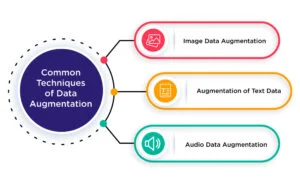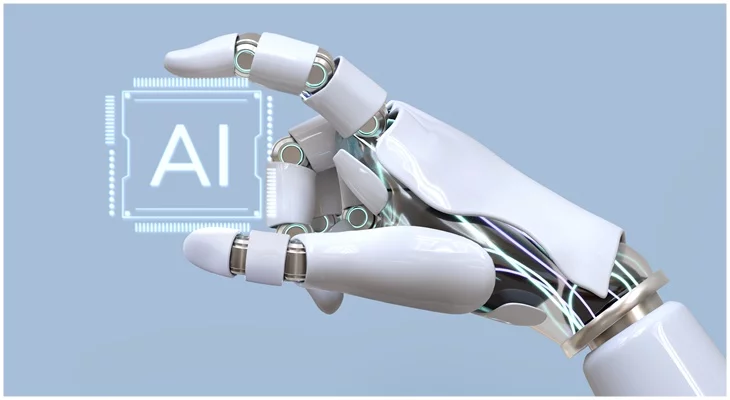Have you ever thought about how machines learn from information? Imagine teaching a child using only a few pictures, which is quite tough, right? In machine learning, data is everything! However, gathering enough data is a challenging task and is a bit expensive. That is where data augmentation comes in! This technique helps us create new, unique examples from the data we already have. It makes our models smarter and more reliable. In this blog, we will talk about what data augmentation is and why it is important in machine learning.
What is Data Augmentation?
Data augmentation is the creation of new data from what you already have with small changes. This way, you get more data without collecting any new samples. This technique helps to improve machine learning models. For example, in images, data augmentation would include rotating, flipping, or zooming in pictures. For texts, it may include changing word order or using synonyms.
For instance, according to a published report, companies using data augmentation techniques have reported a 25% reduction in costs associated with data collection and labeling, making it a more efficient approach.
Common Techniques of Data Augmentation
There are lots of techniques that are used to do data augmentation. The type of technique used majorly depends upon the type of data you are working with. Let's understand some common techniques that are used with different types of data:
1. Image Data Augmentation
Images are one of the most common types of data used in machine learning. Some common techniques to augment image data include:
- Rotation: A model can be inducted to make the image invariable to the orientation of the object in the picture by a certain degree of rotation.
- Flipping: Flipping an image horizontally or vertically helps the model learn patterns in such a way that they are invariant to direction.
- Zooming: Zooming in or out of an image helps to show how far the camera is from the object. This allows the model to pay attention to different parts of the image.
- Translation: Moving the image a bit to any axis (up-down, left-right) helps to train the model in small translations that may have caused objects in an image to disappear.
- Adjust Brightness and Contrast: The addition of brightness and contrast changes improves the model in generalizing even under different lighting conditions.
2. Augmentation of Text Data
Text data is another significant type of data used in machine learning. Some techniques used to augment text data include:
- Synonym Replacement: Changing words to their synonyms (like swapping "happy" for "joyful") adds small changes to the text while keeping the same meaning.
- Word Insertion: Adding random words into a sentence creates different meanings and helps the model be more adaptable.
- Text Paraphrasing: Rewrite different sentences while the original meaning remains the same, and the sentence will change its form.
- Random Deletion: Removes random words of a sentence in order to increase the dependency upon the main contents of the sentence.
3. Audio Data Augmentation
The audio data for speech and audio recognition purposes simulates varied environmental conditions by augmenting techniques:
- Time Stretching: Playing speeded up/slowed-down audio, variations.
- Pitch Shifting: The pitch of the audio is changed to make the model more robust against different speakers or sound environments.
- Noise Injection: Noise injection means adding background sounds, like people talking or traffic, to mimic real-world conditions.
Benefits of Data Augmentation Techniques
Data augmentation techniques offer several benefits that can improve your performance of machine learning models:
Improved Model Performance
The more data a machine learning model has, the better it learns and predicts new information. Data augmentation helps to make your model more accurate by giving it more variety in the data during training, which increases the size of your dataset.
Reduced Overfitting
Overfitting happens when a model performs very well on the training data but not well on new or unseen data. This usually occurs because the model memorizes the training data rather than learning general patterns. Data augmentation helps to reduce overfitting by showing the model to various versions of the data. This makes it less likely to memorize specific details and more likely to learn useful patterns.
For instance, studies show that data augmentation can reduce overfitting by 30-40% in various computer vision tasks, allowing models to perform better on new data.
Cost-Effective
It is expensive and takes a significant time to collect new data and label it. Data augmentation helps to produce new examples based on the existing examples that we already have. This way it saves time and money.
Handling Imbalanced
Datasets In some cases, certain classes in your dataset might have fewer examples than others. This can make the model biased toward the more common classes. Data augmentation helps to balance the datasets. It creates additional examples of the underrepresented classes, making the model fairer and more accurate.
Importance of Data Augmentation Techniques in Machine Learning
Data augmentation is important for creating effective machine-learning models. It helps solve issues with small datasets and improves performance, especially in areas like computer vision, natural language processing, and speech recognition. Data augmentation helps you make your models more accurate as well as versatile while handling most real-world scenarios.
Since artificial intelligence and machine learning are highly advancing, very sophisticated data augmentation techniques have now been developed, and models have become even better at predicting tasks in diversified and complex data. This is important because the data used for the real world is never perfect; it is unstructured and sometimes very limited. The augmentation helps the model adapt to imperfections and, hence, is reliable.
Final Thoughts on Enhancing Machine Learning with Data Augmentation Techniques
Data augmentation techniques are powerful elements of machine learning that can improve model accuracy, prevent overfitting, and save time and resources. It simply applies basic transformations to the existing data, thereby generating a more diverse dataset, which in turn makes your models more robust.
The increasing demand for better-performing machine learning models is sure to make data augmentation a more important factor in developing systems that work well in real-world scenarios. Whether images, text, or audio you are working with, incorporating data augmentation into your workflow is the smart way to boost the performance of your machine learning models.
Learn more about data augmentation at KnowledgeNile!
FAQ
1. What does data augmentation do in machine learning?
A. Data augmentation is the technique of creating more training data from existing data. This way, models learn better and generalize well to new, unseen examples without needing to collect more data.
2. What is the technique of data augmentation?
A. The technique is to modify original data in various ways, including rotating images, replacing words in text, or adding noise to audio. Such changes create new examples, which make the model learn data more effectively.
3. What is the outcome of data augmentation?
A. Data augmentation improves model accuracy, prevents overfitting, and gives models the ability to deal with variations in real data, making them more reliable.
4. How does data augmentation prevent overfitting?
A. Data augmentation increases the richness of training data. This avoids the memorization of specific information in the data by the model. It causes the model to focus on the general patterns present in the data, thus minimizing the chances of overfitting.
You May Also Like:
Human Augmentation Technology and its Real Life Applications
Staff Augmentation Vs. Project Outsourcing: Understanding the Difference






